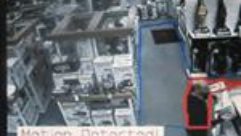
Security Watch: Electronic Article Surveillance
Dec 1, 2007 12:00 PM,
By Steve Filippini
Resonant tags help secure retail merchandise.

EAS systems such as All-tag SuperLabels from Unisen come in many shapes and sizes to help retailers track merchandise and prevent theft.
I was in a clothing store recently because my wardrobe was in serious need of attention. (Curses to the individual who came up with “business casual” for office attire.) As I was gathering up my potential purchases, a 2″×2″ decal fell out of the back pocket of a pair of pants and landed at my feet. When I picked it up, I noticed that between the adhesive and label’s face, there was a thin swirl of copper lines and traces. Having recently been introduced to electronic article surveillance (EAS) systems, I was intrigued by how innocent the clothing tag looked in my hand. As I paid for my clothing, I watched as each article of clothing was passed over an area on the checkout counter with a security label outlined on the surface. After I parted with my money, I looked through the rest of the merchandise for similar decals. I found three more and placed them in my wallet for future reference.
The following week, I attended a seminar on the merits of electronically tagging merchandise and tracking stock. I pulled the tags out of my wallet and compared them to the examples being shown. Aside from the label’s face, they appeared to be identical. From there, my education in EAS systems expanded.
I learned the paper tags, or targets, for example, have two components — a coil designed with a specific inductance value and a capacitor. The value of the coil is a function of the effective area of the coil and the number of turns it has. The size of the capacitor is determined by the inductance of the coil. A tag with a small inductance will require a larger capacitor. The resulting resonant frequency of the tag is a function of both inductance and capacitance.
When an active tag or target passes between or above transmitting antennas, the passive resonant circuit will resonate in the presence of the energy field. For example, the tower may transmit a frequency of 8.2MHz, and any tag tuned for a frequency on or near 8.2MHz will radiate energy back. The antenna will pick up the energy, and the system will react accordingly.
Of course, the tags’ resonant frequency vary from product and manufacturer. Tags and antennas could be tuned anywhere from 1.8MHz to 10MHz, which is a good idea. If everyone used the same setup, detection would be worthless.
The size of the tag is also important. The larger the tag, the more energy it can intercept. The greater the intercepted energy, the greater the reradiated tag signal will be. This is important to consider depending on the type of operating environment the tags will inhabit. A high-noise environment will require the radiated energy signal to be stronger in order to be picked up by the antennas. A stronger energy signal is also needed when the aisles are wide and the antennas need to be located farther apart than usual.

Plastic clips equipped with embedded ink cartridges and requiring a special tool for removal are often used when disposable labels are impractical—for instance, with certain types of clothing.
DETECTION AND DEACTIVATION
Now that we understand the concept and physical makeup of the tags, it’s time to look at the signal antennas. Commonly referred to as towers, or pedestals, these 6ft. structures come in pairs and stand on each side of an entry or aisle. The towers can contain up to three antennas, depending on the range and level of noise cancellation desired. The wider the tower, the farther apart the towers can stand.
Suppose your business’ interior decorator can’t stand the thought of having these devices ruin the motif of the front of the store. An alternative to using upright antennas is to recess them into the floor. During the construction phase of the location, a 24in., 36in., or 45in. antenna panel can be buried at the entry points and connected to a recessed control module where microprocessing takes place. Shielded or non-shielded wiring can be used depending on the make and model of the antenna/microprocessor. The antenna panel is placed above a ferrite shielding plate, which in turn is placed above a base aluminum plate. This reduces the amount of transmitted energy that may be absorbed by the earth, thereby limiting the detection range.
The types of towers available range from simple detection scan and detect of one frequency to high-end models that incorporate digital technology for multiple-tag scanning.
The number of possible forms tags can take is limited only by your imagination. For instance, library books have the logo of the library. Clothing has the adhesive-backed “Inspected by” tag. Books can have the blown-in (loose) tag randomly located between their pages or a thin strip inserted in their spine.
These soft tags or labels are typically left with the product during purchase: Imagine the retail checkout lines if each of these targets had to be removed before the customer left the store. This means the tags have to be deactivated using other means. Some retail stores use a deactivator that destroys the tag’s resonant circuit by emitting an energy field when the target is swept across the reader. This is usually built into the checkout counter for easy scanning and detuning. Deactivation heights for various EAS models range from 5in. to 16in., but I’ve noticed most retail employees simply drag the tags over the reader. Some libraries apply a foil sticker over the tag to shield the tag from resonating and render it useless. This detuning method allows the tag to be reused as needed, but it can be labor intensive.
Electronic article surveillance systems may also take the form of large plastic tags that clip to the material of some types of clothing. These tags require a special tool for removal — usually a large, rounded magnet that retracts an internal ball or clip to allow a spike or pin that runs through the clothing to be easily removed. The clip’s housing is usually plastic, and it wouldn’t require too much effort for the two halves to be pried apart. That is why many of these clips have an indelible ink cartridge embedded in them. Forcing the clips open ruptures the ink cartridge, causing it to stain the material, thus rendering the clothing unwearable. The ink cartridges are available in different colors, are pressurized, and will not freeze. Most clips can be dropped from up to 6ft. without being damaged or ruptured.
WIDENING APPLICATIONS
Use of EAS systems is also expanding beyond retail applications. For instance, a library looking for a misplaced book can benefit from this type of technology. We’ve all picked up books in Dewey Decimal 800 something or other and dropped them off by mistake in another row not even remotely related in topic or content. The library’s records show it hasn’t been checked out, but it’s a real challenge to find the book when that happens. But if the book had a unique tag, a librarian using a handheld detection wand could simply walk past shelves of books and sweep the rows until the missing book was detected.
Of course, this type of technology has its limitations. We already know a foil sticker over the tag’s resonating circuit disables it, so it makes sense that people with less than honest intentions would try to use this information to their advantage. Indeed, retail security people are finding more and more people entering their stores with foil-lined shopping bags and purses. Shoplifters tend to forget that although the tags are disabled when placed in the bags, they still have to get them in the bag undetected. This is getting harder to do because many retail outlets are starting to use sensors that look for foil-lined clothing and bags when customers walk into a store. A silent signal is relayed to a loss-prevention officer, and the customer wins a free escort while in the store. Granted the technology is not foolproof, and it still has a way to go before it is widely used, but it has proven to be effective in some test markets.
By the way, during my shopping spree, I took the tag that fell out of the pants pocket and patted it on the shoulder of my buddy, who waltzed out the door amid buzzers and lights. Maturity is so highly overrated.
Steve Filippiniis a project manager with more than 27 years of experience in the security and installation industry. He can be reached at[email protected].










